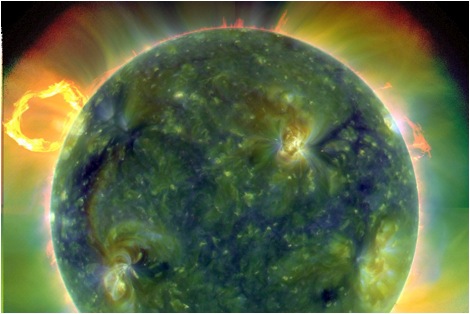
I’d like to describe another technical problem that the MAVEN team dealt with during the recently completed Preliminary Design Phase (Phase B). Spacecraft electronics can be upset by cosmic rays or by high-energy particles emitted during solar flares. For example, one of these particles can cause a change in the spacecraft memory. It can cause a binary stored value to change (e.g., from a 0 to a 1), and is called a “single event upset”, or SEU; that is, the electronics are upset by a single event of a cosmic-ray hit. If this change occurs in a key place in the spacecraft memory, the spacecraft could find itself not knowing what it should be doing, and will go in to a “safe hold” mode. In its safe mode, the spacecraft shuts down all non-essential operations, makes sure that the solar panels are pointed at the sun so that it has electrical power, and contacts Earth to await further instructions. The spacecraft may also decide that the computer has had sufficient problems that it would switch to the backup computer. Entry into safe mode happens for various reasons with essentially all planetary spacecraft, sometimes perhaps once and sometimes several times per year.
With MAVEN, the same solar-flare events that can trigger entry into safe mode can affect the Mars upper atmosphere and trigger loss of atmospheric gas. We’d like to observe these events without interruption, of course, measuring both the energetic particles hitting the upper atmosphere and the atmospheric response. But if the spacecraft enters safe mode, we can’t make the observations! It can take several days to a week to recover from the event, or even longer if it’s hard to determine the cause of the event, and by that time the effects of the flare at Mars will have dissipated.
The spacecraft team did an analysis of how the electronics could be affected by a large solar flare – looking at each circuit, seeing what would happen if it got hit by a cosmic ray, and determining the consequences. It turned out that even moderately large flares could cause an SEU and send the spacecraft into safe mode.
However, the analysis also suggested a fix. The flight software could be modified relatively simply so that there would be regular “refreshes”, in which all of the critical memory value locations would be reset to their intended state. This would keep SEU memory errors from accumulating, as it generally requires multiple SEU errors to trigger a significant problem. By making this fix, MAVEN would have a very high probability of going through even a worst-case plausible flare without interruption. The spacecraft would be more robust, and we would be able to obtain the measurements we were looking for!
This process is how the spacecraft and project team operated during Phase B – identifying potential problems, evaluating how serious they could be, and looking for straightforward means by which to resolve them.

